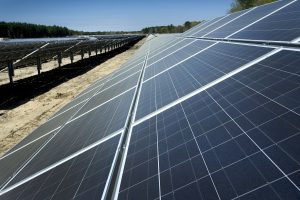Earlier this year an energy company called Sun Cable inked a development agreement for an ambitious solar farm project in Australia. The plan is to build a 12,000 hectare solar farm located in the sparsely populated and well-sunned Northern Territory. It will have a capacity of 10 GW, and a battery component capable of storing up to 30 GWh. In its initial phase, the solar farm will provide electricity to the Darwin-Katherine grid, and the project is expected to cost A$22 billion (approximately US$17 billion). To give a sense of scale, in 2019 Australia’s total installed capacity was around 50 GW.
Building a 12,000 hectare solar farm equal to one fifth of Australia’s domestic grid capacity is already wildly ambitious. But project planners aren’t content with stopping at Darwin. The plan also calls for the construction of a 3,750 kilometer undersea cable from Darwin to Singapore. The rough estimate is that the Sun Cable solar farm will be able to provide Singapore with one fifth of its electricity before the end of the decade. The Australian federal government has faith in this idea, as Canberra awarded it major project status in 2020.
The entire undertaking is Elon Muskian in its scope and vision. But at the moment there is a major piece of the puzzle missing: the government of Singapore has not agreed to buy any of this power. Neither have any other countries in Southeast Asia, even though the project developers are clearly hoping they will be able to break into the booming Southeast Asian energy market. That this is the desired end-game can be gleaned from the fact that they named it the Australia–ASEAN Power Link.
This idea has gotten a lot of press coverage because of its scale and ambition. But Sun Cable has not yet lined up all the financing. The deadline for financial closing is in 2023, and the truth about big power projects is that it’s mostly just a lot of noise until the funders actually start releasing the money. And there are a couple things in this plan that might give underwriters some pause. One is the lack of a concrete agreement with Singapore. I think there is a good chance that can be overcome, especially as the developer Sun Cable is a Singaporean company.
It would serve the Singaporean government’s long-term interests to have a local company get a multi-billion dollar contract to develop a technically advanced and ambitious solar farm in Australia. It makes economic sense and would help them meet their renewable energy commitments. Given land constraints on the island, there’s really no option to develop similar industrial-scale solar power domestically. But Singapore becoming the entry point for Australia’s clean energy exports to the rest of Southeast Asia is altogether a trickier matter.
Indonesia has been name-dropped as the most likely potential market. But Indonesia, which has deep reserves of coal and strong undercurrents of economic and resource nationalism, does not look kindly on imports and especially energy imports. Just this month President Jokowi bombastically declared that Indonesians should hate foreign imports. That was obviously a bit of a rhetorical flourish, but it is rooted in this deeper aversion to imports especially when there is an existing domestic supply. And that fundamental logic of Indonesia’s political economy is going to be hard for the Australian–ASEAN Power Link to break through.
Indeed, most countries in Southeast Asia are averse to imports because they prefer to run current account surpluses as a basic tenet of economic policy. Vietnam and Thailand have recently started growing their domestic renewable energy sectors in earnest precisely to avoid fossil fuel imports. Trading fossil fuel imports for clean energy imports might be better for the environment, but it won’t be better for the current accounts of these fast-growing regional economies.
It’s of course possible these obstacles can be overcome with the right mix of incentives and effective negotiation, but it’s important to recognize what the practical impediments are and have a plan for engaging with them. The vision of a giant solar farm in the Northern Territory pumping out clean energy through an underwater cable to markets thousands of kilometers away has an immediate and striking allure. But on its own, it won’t be enough to change some basic facts of the region’s political economy.

































